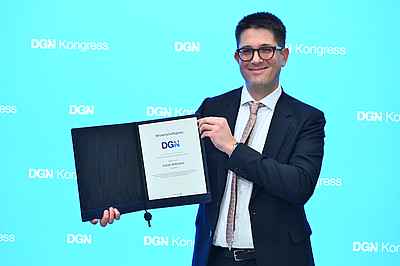Sie befinden sich hier
Inhalt
Date: 07.11.2024
At the opening ceremony of the DGN Congress (November 6-9 in Berlin) Prof. Dr. med. Lucas Schirmer, Head of the Division of Neuroimmunology in the Department of Neurology at the UMM and personal core member at the MCTN, received the Science Award of the German Society of Neurology (DGN). With this award, the DGN honors German-speaking clinical neurologists for their research into the pathogenesis, diagnosis and therapy or the pathological anatomy of diseases of the nervous system.
With this award, the DGN honors Lucas Schirmer's outstanding scientific work in the field of translational neurobiology. In recent years, three of the awardee's highly published papers can be described as milestones in neuroimmunological research.
One of the awardee's papers was published in Nature in 2019 and has made a significant contribution to the pathophysiological understanding of multiple sclerosis (MS) [1]. MS shows heterogeneous lesion patterns in the cortical gray matter and subcortical white matter, as well as signs of neurodegeneration over the course of the disease, which Lucas Schirmer was able to characterize at the molecular level using single-cell nuclear RNA sequencing (snRNA-seq). He detected altered gene expression in MS lesions in several neuronal cell lines and validated the results using multiplex in situ hybridization. Building on these results, Lucas Schirmer's team is now working to combine snRNA-seq with high-resolution spatial "omics" methods to map cell type-specific changes to precise spatial coordinates in the tissue and to measure cell-cell interactions.
In MS, Lucas Schirmer and his team discovered patterns of damage not only in neuronal cell bodies, but also in the nerve processes (axons). It was shown that even in the early stages of the disease, pronounced neuronal stress responses lead to progressive axonal degeneration and death of nerve cells. This led the group to hypothesize that chronic neuronal hyperexcitability plays a role. The publication in the Journal of Clinical Investigation caused an international sensation in 2023 because it identified the potassium channels of Ranvier's cords as a completely new therapeutic target for MS [2]. Pharmacological opening of the Kv7 channel with the drug retigabine reduced the hyperexcitability of human and murine neurons decreased and improved clinical MS symptoms in animal models.
With his extensive expertise in transgenic neuroinflammatory model systems, single-cell nuclear RNA sequencing and spatial transcriptomics, Lucas Schirmer has also been working for several years on inflammatory muscle diseases, in particular the largely unexplored inclusion body myositis (IBM), the most common inflammatory myopathy in the elderly. In July of this year, his team published in Nature Aging a multi-center, international study on IBM [3], in which muscle biopsies were examined using the snRNA-seq method in combination with spatial gene expression analyses and previously unknown molecular changes were discovered. These results provide new insights into the possible mechanisms of muscle fiber degeneration in IBM and reveal several potential therapeutic options.
"Prof. Schirmer's research has contributed significantly to a better understanding of neuroinflammatory diseases and has identified several new, promising therapeutic targets. His publications are scientific milestones in neuroimmunology and have attracted great international attention," said laudator and DGN Congress President Prof. Dr. Sven Meuth.
[1] Schirmer L, Velmeshev D, Holmqvist S, Kaufmann M, Werneburg S, Jung D, Vistnes S, Stockley JH, Young A, Steindel M, Tung B, Goyal N, Bhaduri A, Mayer S, Engler JB, Bayraktar OA, Franklin RJM, Haeussler M, Reynolds R, Schafer DP, Friese MA, Shiow LR, Kriegstein AR, Rowitch DH. Neuronal vulnerability and multilineage diversity in multiple sclerosis. Nature. 2019 Sep; 573 (7772): 75-82. DOI: 10.1038/s41586-019-1404-z
[2] Kapell H, Fazio L, Dyckow J, Schwarz S, Cruz-Herranz A, Mayer C, Campos J, D'Este E, Möbius W, Cordano C, Pröbstel AK, Gharagozloo M, Zulji A, Narayanan Naik V, Delank A, Cerina M, Müntefering T, Lerma-Martin C, Sonner JK, Sin JH, Disse P, Rychlik N, Sabeur K, Chavali M, Srivastava R, Heidenreich M, Fitzgerald KC, Seebohm G, Stadelmann C, Hemmer B, Platten M, Jentsch TJ, Engelhardt M, Budde T, Nave KA, Calabresi PA, Friese MA, Green AJ, Acuna C, Rowitch DH, Meuth SG, Schirmer L. Neuron-oligodendrocyte potassium shuttling at nodes of Ranvier protects against inflammatory demyelination. J Clin Invest. 2023 Apr 3; (7): e164223. DOI: 10.1172/JCI164223
[3] Wischnewski S, Thäwel T, Ikenaga C, Kocharyan A, Lerma-Martin C, Zulji A, Rausch HW, Brenner D, Thomas L, Kutza M, Wick B, Trobisch T, Preusse C, Haeussler M, Leipe J, Ludolph A, Rosenbohm A, Hoke A, Platten M, Weishaupt JH, Sommer CJ, Stenzel W, Lloyd TE, Schirmer L. Cell type mapping of inflammatory muscle diseases highlights selective myofiber vulnerability in inclusion body myositis. Nat Aging. 2024 Jul; 4 (7): 969-983. DOI: 10.1038/s43587-024-00645-9
Source: Press release German Society of Neurology
Press release of the German Society of Neurology (German language):
06.11.2024 Prof. Lucas Schirmer, Mannheim, erhält den DGN-Wissenschaftspreis
Most recent scientific publications:
Cell type mapping reveals tissue niches and interactions in subcortical multiple sclerosis lesions.
Lerma-Martin C, Badia-i-Mompel P, Ramirez Flores RO, Sekol P, Schäfer PSL, Riedl CJ, Hofmann A, Thäwel T, Wünnemann F, Ibarra-Arellano MA, Trobisch T, Eisele P, Schapiro D, Haeussler M, Hametner S, Saez-Rodriguez J, Schirmer L.
Nature Neuroscience. 2024 November 5
DOI: 10.1038/s41593-024-01796-z

